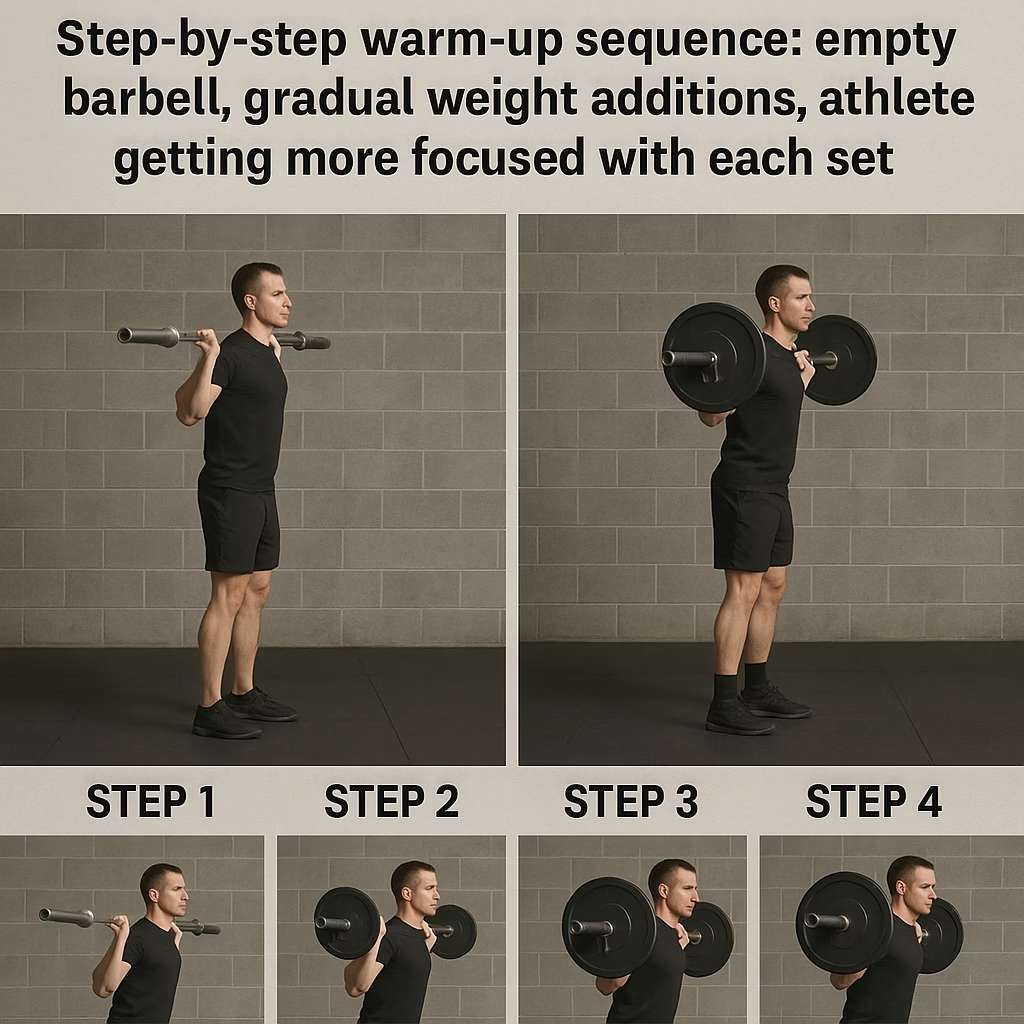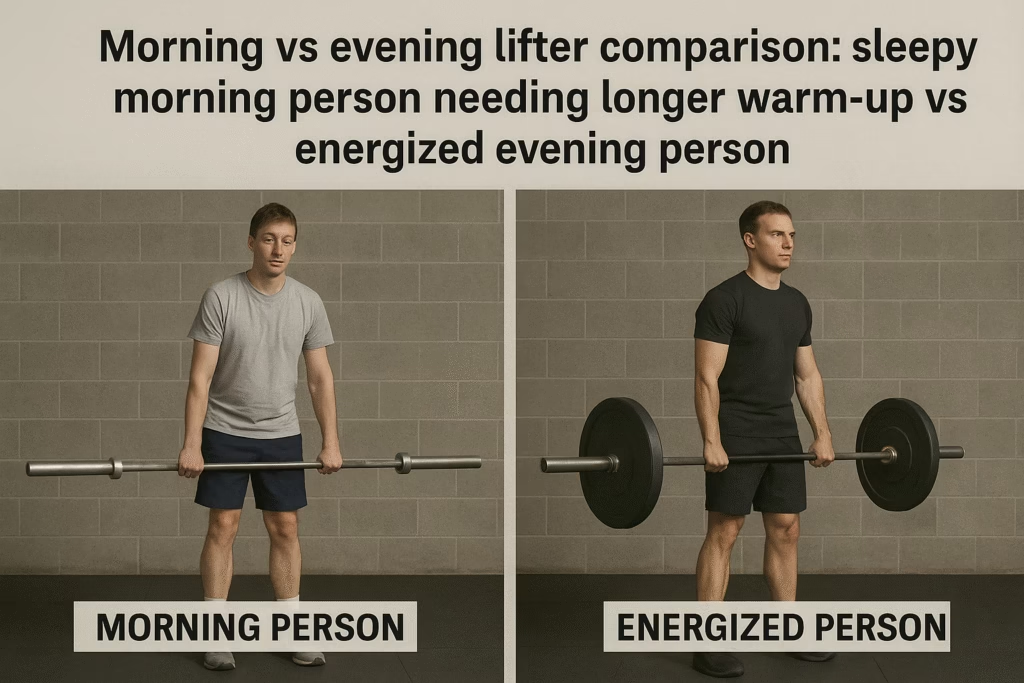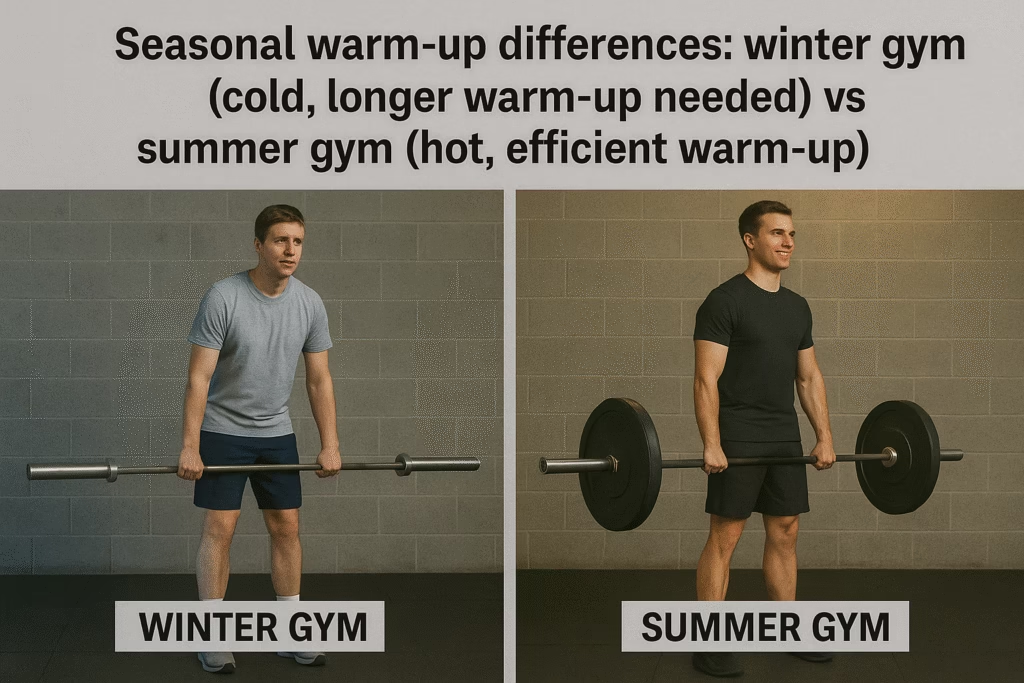Skip the 20-minute treadmill marathon. Your warm-up should prep your body for war, not exhaust you before battle. Here’s how the pros actually do it.
Why Most People Screw Up Their Warm-Up
Walk into any gym and you’ll see two types of people:
Type 1: Jumps straight to their working weight like they’re invincible (spoiler: they’re not)
Type 2: Spends 45 minutes on cardio, then wonders why they can barely lift their gym bag
Both are doing it wrong. Here’s the truth: Your warm-up should be a ramp, not a mountain.
The Science (Don’t Worry, We’ll Keep It Simple)
What your body needs before heavy lifting:
- Blood flow to working muscles
- Joint mobility and range of motion
- Nervous system activation (wake up those muscle fibers!)
- Movement pattern rehearsal
- Mental preparation
What your body DOESN’T need:
- To be tired before you even start
- Excessive stretching that makes you looser than overcooked pasta
- Generic movements that have nothing to do with your lifts
The Perfect Heavy Lift Warm-Up Formula

Phase 1: General Warm-Up (5-8 minutes)
Goal: Get your heart pumping and joints moving
Do This:
- Light cardio (5-10 minutes max)
- Dynamic stretching
- Joint circles and basic movements
Don’t Do This:
- Marathon cardio sessions
- Static stretching (save it for after)
- Anything that makes you sweat buckets
Phase 2: Specific Warm-Up (10-15 minutes)
Goal: Prepare for your exact lifts
The Magic Formula:
- Start with empty barbell
- Add weight in 10-20% jumps
- Decrease reps as weight increases
- Stop 1-2 sets before your working weight
Phase 3: Activation (3-5 minutes)
Goal: Fire up your nervous system
Quick activation moves:
- Band pull-aparts
- Glute bridges
- Plank variations
- Light explosive movements
Warm-Up Protocols by Lift
Squats: From Zero to Hero
| Weight | Reps | Rest | Notes |
|---|---|---|---|
| Bodyweight | 10-15 | 30s | Deep, controlled |
| Empty bar (45lbs) | 8-10 | 45s | Full range of motion |
| 25% of working weight | 5-6 | 60s | Focus on form |
| 50% of working weight | 3-4 | 90s | Add some speed |
| 75% of working weight | 2-3 | 2-3min | Competition tempo |
| 85% of working weight | 1 | 3-4min | Final prep |
Pre-Squat Activation:
- Leg swings (front/back, side to side)
- Walking lunges
- Glute bridges
- Ankle circles
Deadlifts: Wake Up Your Posterior Chain
The Deadlift Dilemma: You can’t really practice deadlifts light (the bar won’t reach the floor). Here’s the workaround:
Preparation sequence:
- Romanian deadlifts with light weight
- Deadlifts from blocks/pins (higher starting position)
- Gradually lower the starting height
- Work up to floor deadlifts
| Weight | Reps | Rest | Notes |
|---|---|---|---|
| Light RDLs | 8-10 | 45s | Feel the pattern |
| 40% from blocks | 5 | 60s | Hip hinge focus |
| 60% from floor | 3-4 | 90s | Full movement |
| 80% | 2 | 2-3min | Competition speed |
| 90% | 1 | 3-4min | Final prep |
Bench Press: Upper Body Domination
| Weight | Reps | Rest | Notes |
|---|---|---|---|
| Empty bar | 10-12 | 30s | Full range, controlled |
| 30% of working weight | 6-8 | 45s | Focus on setup |
| 50% of working weight | 4-5 | 60s | Add some speed |
| 70% of working weight | 2-3 | 90s | Competition pause |
| 85% of working weight | 1-2 | 2-3min | Final groove |
Pre-Bench Activation:
- Arm circles and shoulder rolls
- Band pull-aparts
- Push-ups (light)
- Scapular wall slides
The “Oh Shit, I’m Running Late” Quick Warm-Up
Got 10 minutes? Here’s your emergency protocol:
- 2 minutes: Light movement (jumping jacks, arm swings)
- 3 minutes: Empty bar for your main lift (high reps)
- 5 minutes: Quick weight progression (bigger jumps, fewer sets)
It’s not ideal, but it beats going in cold.
Common Warm-Up Mistakes That Kill Your Lifts

Mistake #1: The Cardio Queen/King
What they do: 30 minutes on the elliptical before squats Why it sucks: You’re already tired before you start lifting Fix: 5-10 minutes light cardio MAX
Mistake #2: The Static Stretcher
What they do: Hold stretches for 30+ seconds before lifting Why it sucks: Makes muscles temporarily weaker Fix: Save static stretching for after your workout
Mistake #3: The Weight Jumper
What they do: Go from empty bar straight to 80% of their max Why it sucks: Muscles and nervous system aren’t ready Fix: Gradual progression with the formula above
Mistake #4: The Over-Warmer
What they do: 20+ warm-up sets before their working weight Why it sucks: Fatigue accumulation kills performance Fix: 4-6 warm-up sets should be plenty
Mistake #5: The Generic Warmer
What they do: Same warm-up for every exercise Why it sucks: Different lifts need different preparation Fix: Lift-specific warm-ups
Advanced Warm-Up Strategies
The Competition Prep
For when you’re going for PRs:
- Extra time between warm-up sets
- Practice your competition commands
- Mental rehearsal between sets
- Specific equipment if you use it
The High-Frequency Approach
For daily lifters:
- Shorter warm-ups (your body adapts)
- Focus on problem areas
- Quick movement quality checks
- Listen to your body
The Injury Prevention Protocol
For lifters with problem areas:
- Extra attention to problem joints
- Corrective exercises during warm-up
- Temperature consideration (cold gyms need longer warm-ups)
- Pain vs. stiffness assessment
Warm-Up Timing Strategy

Morning Lifters
- Need longer warm-ups (your body’s been asleep)
- Extra joint mobility work
- Hot shower before gym (seriously helps)
- Caffeine timing (20-30 minutes before lifting)
Evening Warriors
- Usually need less warm-up time
- Body’s already been moving all day
- Watch for accumulated fatigue
- Stress management (work stress affects lifting)
The Mental Game of Warming Up
Your warm-up isn’t just physical – it’s psychological prep:
- Visualization: See yourself crushing your lifts
- Breathing: Control your nerves with breathing patterns
- Routine: Consistent warm-up creates confidence
- Music: Get your pump-up playlist ready
Equipment Considerations
Knee Sleeves and Wraps
- Put them on during your 60-70% sets
- Not too early (you’ll overheat)
- Not too late (joints need prep time)
Belts
- Start using around 80% of your working weight
- Practice your breathing with the belt on
- Don’t warm up with it (you need core activation first)
Chalk
- Have it ready for heavier warm-up sets
- Don’t overthink it, just use when grip becomes a factor
Sample 20-Minute Heavy Squat Warm-Up
Minutes 1-5: General Prep
- 3 minutes light cardio
- Leg swings (10 each direction)
- Walking lunges (10 each leg)
- Bodyweight squats (15 reps)
Minutes 6-15: Specific Warm-Up
- Empty bar: 10 reps (1 min rest)
- 135lbs: 6 reps (1 min rest)
- 185lbs: 4 reps (90s rest)
- 225lbs: 2 reps (2 min rest)
- 275lbs: 1 rep (3 min rest)
Minutes 16-20: Final Prep
- Put on knee sleeves
- Mental preparation
- Set up for working weight (315lbs+)
The Numbers Game: How Much Is Enough?
Research-backed warm-up guidelines:
- Total warm-up time: 15-25 minutes for heavy lifting
- Specific warm-up: 4-6 sets increasing in weight
- Rest between warm-up sets: 1-3 minutes (longer as weight increases)
- Final warm-up weight: 85-90% of your working weight
Seasonal Adjustments

Winter Gym Life
- Longer warm-ups (cold muscles need more time)
- Extra layers during warm-up
- Hot drinks before training
- Pay attention to joint stiffness
Summer Training
- Stay hydrated during warm-up
- Don’t overheat with excessive warm-up
- Air conditioning considerations
- Adjust for outdoor training
When to Skip Parts of Your Warm-Up
Green Light to Abbreviate:
- You’re training the same lift multiple days in a row
- Gym is hot and you’re already sweating
- You’re doing light technique work
- Time constraints (but be smart about it)
Red Light – Never Skip:
- First time lifting in days
- Going for PRs or competition attempts
- Cold environment
- Previous injury history in that movement
Warm-Up Troubleshooting
“I Feel Weak After Warming Up”
Possible causes:
- Too much volume in warm-up
- Resting too long between sets
- Starting too heavy too fast
Solutions:
- Reduce warm-up volume
- Keep rest periods consistent
- Smaller weight jumps
“I Never Feel Ready”
Possible causes:
- Not enough activation work
- Rushing through warm-up
- Mental preparation lacking
Solutions:
- Add explosive movements
- Slow down, focus on quality
- Visualization and breathing work
“My Warm-Up Takes Forever”
Possible causes:
- Too many unnecessary sets
- Social media breaks (be honest)
- Overthinking each set
Solutions:
- Stick to the formula
- Phone in locker during warm-up
- Set timers for rest periods
FAQs
Q: Should I do cardio before lifting heavy?
A: 5-10 minutes max. You want to raise your heart rate, not exhaust yourself. Think warm-up, not workout.
Q: How long should I rest between warm-up sets?
A: Start with 30-60 seconds for light weights, work up to 2-3 minutes for your heaviest warm-up sets. Your body needs time to recover as weight increases.
Q: Can I skip warm-up if I’m just doing light weights?
A: Define “light.” If it’s truly light technique work, you can abbreviate. But even “light” weights can cause injury if your body isn’t prepared.
Q: Should I warm up differently for different lifts on the same day?
A: Yes and no. Your general warm-up covers the basics, but each lift needs specific movement preparation. Don’t start from zero each time, but don’t ignore lift-specific needs.
Q: What if I feel tight during my warm-up?
A: Tight muscles usually loosen up with movement. If something feels genuinely painful or restricted, address it before adding weight. Better to spend extra time warming up than weeks recovering from injury.
Q: Is it bad to sweat during warm-up?
A: Light sweating is fine and normal. Dripping sweat means you’re probably overdoing it and might fatigue yourself before your main lifts.
Q: Should I use the same warm-up every time?
A: Consistency is good, but listen to your body. Some days you’ll need more mobility work, other days you’ll feel ready faster. The framework stays the same, but adjust based on how you feel.
Q: Can I warm up with different exercises than my main lift?
A: For general warm-up, absolutely. For specific warm-up, you want to practice the exact movement pattern you’ll be using. Goblet squats are great for mobility, but you still need to warm up with a barbell before barbell squats.



